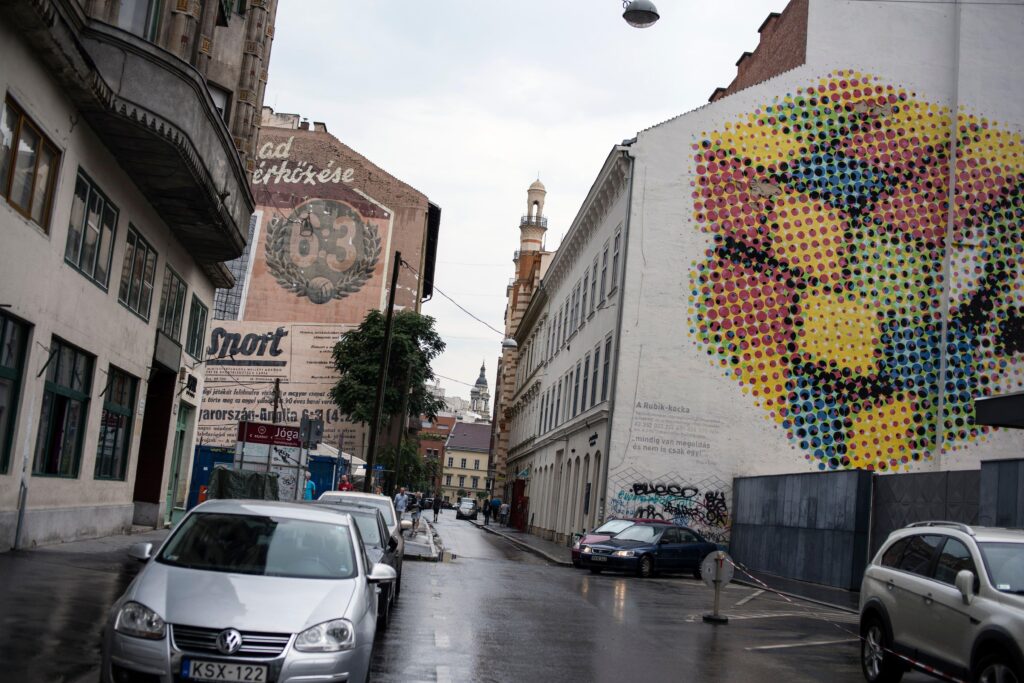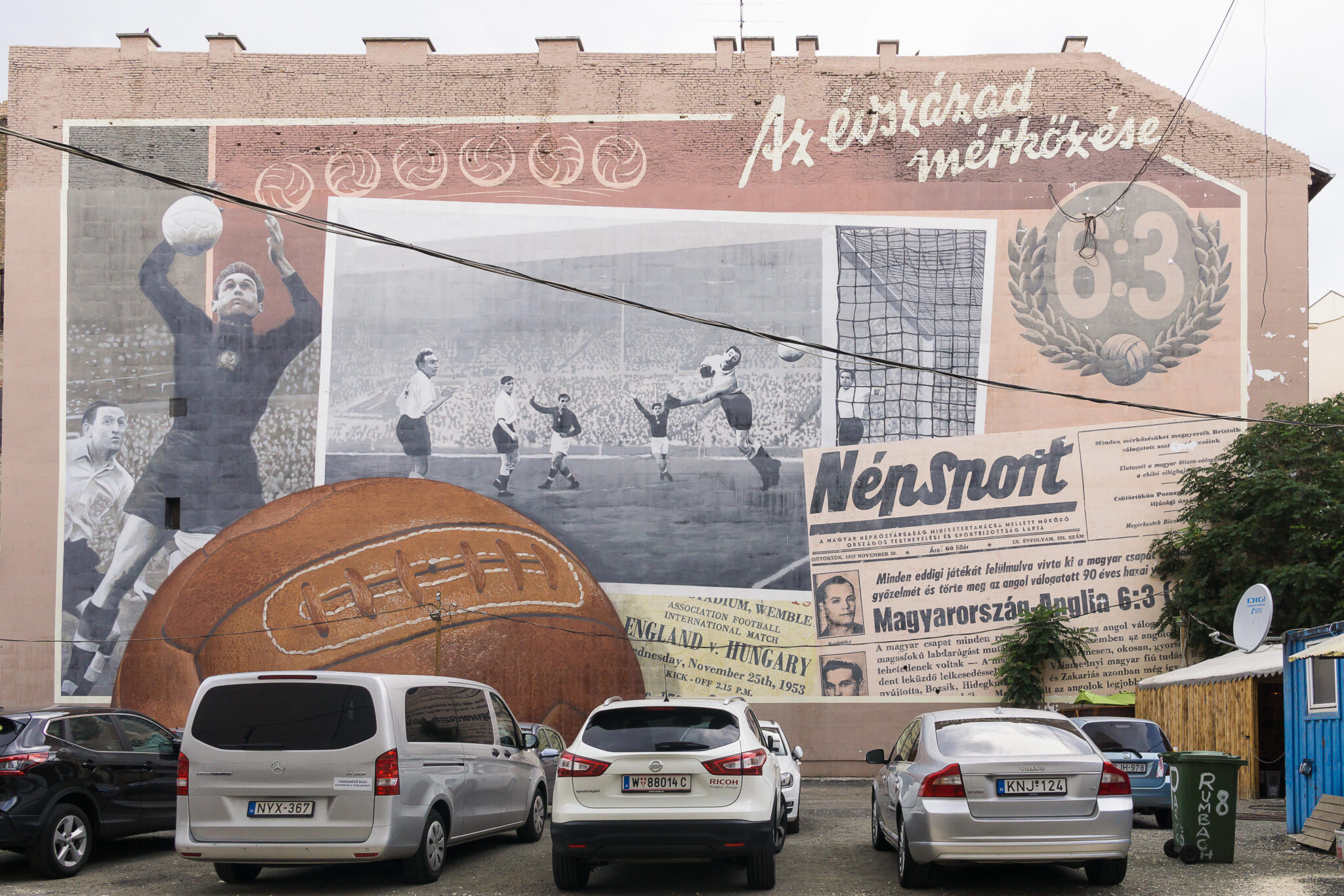Budapest is already known for its bohemian vibe, lively nightlife, delicious food, and laid-back cafe and pub culture. Now, the city is also getting known for its great street art movement, which is powered by the work of local and international artists who put their art on walls in the city.
Street art, murals, and graffiti
The spontaneous and somewhat mischievous efforts of local painters gave rise to the street art culture in Budapest. As the city around them grew, they saw more and more courtyards surrounded by ugly, empty walls. They decided to give these courtyards some life.
Locals were so moved by the new colour it brought to their lives that, rather than denouncing them as graffiti, they celebrated them as masterpieces, and soon, searching for new ones became a game for the community.
Street art reflecting culture, history, and lifestyle

One of the recurring themes of the murals painted on the city’s walls is honouring the individuals who have contributed to Hungary’s diverse culture.
Hungarian culture is an intriguing thing that has evolved over more than a thousand years and has been impacted by the various civilizations and empires that have claimed the nation throughout time. Hungary is known for its creativity. Many mathematicians and physicists have done groundbreaking work in the country over the years.
Another reoccurring theme in the street art scene in Budapest is commemorating Hungarian history, mainly by paying tribute to the heroes of the country. Hungary’s more than a thousand-year history has inspired plenty of artists to paint on the boring city walls.
Returning to the present, numerous murals perfectly represent the energy and excitement of Budapest’s metropolitan culture. The city is rapidly expanding, is beloved by foreigners and visitors from all over the world, and has much to be proud of, which gives plenty of explanation as to why so many streets and walls are covered with quirky, colourful paintings reflecting the life in Budapest.
The Rubik’s cube mural, Dob Street
The Rubik’s Cube, created by Hungarian Ernő Rubik, is a straightforward toy that has delighted millions of people over the years. This is commemorated in Erzsébetváros by a 3D Rubik’s cube made from thousands of radiating and vibrant dots. According to the artist, the piece is a reflection on the idea that, like the Rubik’s Cube, “there is always a solution—and not just one”—to problems in life.
Man of the Year, Wesselényi Street
A key event for the city was the 1956 revolution. Despite failing to entirely destroy Communism, citizens were able to secure significant reforms that gave Hungary a much more liberal environment than many of its neighbours.
The Man of the Year mural honours the soldiers who fought for freedom by simply copying the iconic Time Magazine cover created by Boris Chaliapin for the occasion.
Portrait of Angel Sanz Briz, Dob Street
An eye-catching, almost Cubist mural is perched on a firewall above a restaurant as you enter Dob Street in the Jewish Quarter. It shows a man against a bizarre, vivid background. The painting was created by Spanish artist Okuda San Miguel in honour of Spanish diplomat Angel Sanz Briz, who in 1944 saved as many as 5,000 Hungarian Jews from the Holocaust.
The Spanish Embassy in Hungary helped fund the mural in the former Jewish Ghetto to honour the man referred to as the “Angel of Budapest” or the “Spanish Schindler.”
6:3, Rumbach Sebestyén Street
Hungary used to be quite good at football. Stars of the time, Öcsi Puskás and his “Golden Team” defeated every opponent they faced on the pitch. However, their 6-3 victory over England stands out as their most famous triumph, and this mural honours it.
This charming piece, which is set up as a photo, news articles, and a football, serves as a reminder of a happier Hungary’s athletic past.
Sunrise or Sunset, Kazinczy Street
This artwork, located in the centre of the party district, is based on the Hungarian dichotomy “Sunrise, or sunset.” It serves as a kind of map for visitors, suggesting all that the neighbourhood has to offer, both during the day and at night. The map highlights some of the most popular bars and restaurants in the surrounding streets.
Budapest isn’t too small, Kazinczy Street
As if the opposite of the Sunrise or Sunset painting, this mural, which also resembles a map and is placed in Kazinczy Street, serves more as a call to leave the Jewish Quarter and have a brief tour of the rest of the city. When the party area is compared to the rest of the city as it is done here, the party district may appear large to visitors, but you’ll quickly be yearning to explore and get to the other parts of the city.
Vocabulary
| laid-back | laza |
| local | helyi |
| international | nemzetközi |
| spontaneous | spontán |
| mischievous | pajkos |
| courtyard | udvar |
| to denounce | elítélni |
| masterpiece | mestermű |
| community | közösség |
| recurring | visszatérő |
| mural | falfestmény |
| to contribute | hozzájárulni |
| diverse | változatos |
| intriguing | érdekes |
| to impact | hatással lenni |
| empire | birodalom |
| groundbreaking | úttörő |
| to commemorate | megemlékezni |
| mainly | főleg |
| to pay tribute | tisztelegni |
| hero | hős |
| plenty of | rengeteg |
| boring | unalmas |
| excitement | izgalom |
| beloved | szeretett |
| explanation | magyarázat |
| quirky | furcsa |
| Rubik’s Cube | Rubik-kocka |
| straightforward | egyenes |
| toy | játék |
| delighted | elragadtatott |
| radiating | sugárzó |
| vibrant | élénk |
| dot | pont |
| solution | megoldás |
| key | kulcsfontosságú |
| revolution | forradalom |
| significant | jelentős |
| liberal | liberális |
| cover | címlap |
| eye-catching | szemet gyönyörködtető |
| firewall | tűzfal |
| vivid | élénk |
| embassy | nagykövetség |
| to fund | finanszírozni |
| Golden Team | Aranycsapat |
| opponent | ellenfél |
| pitch | pálya |
| triumph | diadal |
| party district | bulinegyed |
| dichotomy | kettősség, ellentmondás |
| neighbourhood | környék |
| surrounding | környező |
| to resemble | hasonlítani |
| brief | rövid |
| to yearn | vágyakozni |






